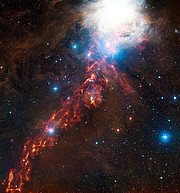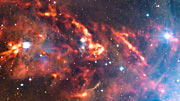Persbericht
Het vurige verborgen lint van Orion
15 mei 2013
Op deze spectaculaire nieuwe opname van kosmische wolken in het sterrenbeeld Orion is een soort vurig lint te zien. De oranje gloed stelt zwak licht voor, onzichtbaar voor het menselijk oog, dat door koude interstellaire stofdeeltjes is uitgezonden. Dit licht is vastgelegd met het door ESO beheerde Atacama Pathfinder Experiment (APEX) in Chili.
Wolken van interstellair gas en stof zijn de grondstoffen voor de vorming van sterren. Maar de minuscule stofdeeltjes versperren ons zicht op wat zich in en achter die wolken bevindt – op zichtbare golflengten althans. Hierdoor laat het stervormingsproces zich moeilijk waarnemen.
Daarom moeten astronomen instrumenten gebruiken die licht van andere golflengten kunnen zien. Op submillimetergolflengten houden de stofdeeltjes geen licht tegen, maar stralen ze door hun lage temperaturen van enkele tientallen graden boven het absolute nulpunt [1] juist licht uit. De APEX-telescoop en zijn submillimeter-camera LABOCA, op de 5000 meter hoge Chajnantor-hoogvlakte in de Chileense Andes, zijn uitermate geschikt voor dit soort waarnemingen.
Deze nieuwe opname toont slechts een gedeelte van een groot complex van heldere gaswolken, hete jonge sterren en koude stofwolken in het sterrenbeeld Orion. Het Orioncomplex is honderden lichtjaren groot en ongeveer 1350 lichtjaar van ons verwijderd. De submillimeter-gloed van de koude stofwolken is hier oranje afgebeeld en over een ‘normale’ foto van het gebied heen gelegd.
De grote heldere wolk rechtsboven is de bekende Orionnevel oftewel Messier 42. Deze is met het blote oog gemakkelijk te zien als de enigszins wazige middelste ‘ster’ in het zwaard van Orion. De Orionnevel is het helderste deel van een enorme stellaire kraamkamer waarin nieuwe sterren worden geboren. Van alle grote stervormingsgebieden is dit het dichtstbijzijnde.
De stofwolken vormen prachtige draden, plooien en bellen. Deze zijn het gevolg van processen zoals gravitationele samentrekking en de effecten van sterrenwinden. Dat laatste zijn gasstromen uit de atmosferen van sterren, die krachtig genoeg zijn om allerlei kronkelvormen in de omringende gaswolken te veroorzaken.
Astronomen hebben deze en andere gegevens van APEX gecombineerd met opnamen van ESA’s ruimtetelescoop Herschel om naar protosterren – een vroeg stadium van stervorming – te zoeken. Tot nu toe hebben ze vijftien objecten opgespoord die op langere golflengten veel helderder zijn dan op kortere golflengten. Deze zeldzame objecten behoren waarschijnlijk tot de jongste protosterren die ooit zijn waargenomen. Ze brengen astronomen een stapje dichter bij de waarneming van de eerste fase van de stervorming.
Noten
[1] Naarmate een object heter is, zendt het licht van kortere golflengten uit. Daarom zien zeer hete sterren (met temperaturen rond 20.000 graden) er blauw uit en ‘koele’ sterren (van 3000 graden) rood. Een wolk van stof met een temperatuur van slechts tien kelvin – tien graden boven het absolute nulpunt – zendt vooral straling uit op een golflengte die nog veel langer is dan die van rood licht (0,3 millimeter). Dat is het soort straling waar APEX heel gevoelig voor is.
Meer informatie
Het onderzoek van protosterren in dit gebied staat beschreven in het artikel ‘A Herschel and APEX Census of the Reddest Sources in Orion: Searching for the Youngest Protostars’ van A. Stutz et al., dat in de Astrophysical Journal is verschenen.
De APEX-waarneming die voor deze foto zijn gebruikt, stonden onder leiding van Thomas Stanke (ESO), Tom Megeath (Universiteit van Toledo, VS) en Amelia Stutz (Max-Planck-Institut für Astronomie, Heidelberg, Duitsland). APEX is een samenwerking tussen het Max-Planck-Institut für Radioastronomie (MPIfR), het Onsala Space Observatory (OSO) en ESO. Het beheer van APEX op Chajnantor is toevertrouwd aan ESO.
ESO is de belangrijkste intergouvernementele astronomische organisatie in Europa en de meest productieve sterrenwacht ter wereld. Zij wordt ondersteund door vijftien landen: België, Brazilië, Denemarken, Duitsland, Finland, Frankrijk, Italië, Nederland, Oostenrijk, Portugal, Spanje, Tsjechië, het Verenigd Koninkrijk, Zweden en Zwitserland. ESO voert een ambitieus programma uit, gericht op het ontwerpen, bouwen en beheren van grote sterrenwachten die astronomen in staat stellen om belangrijke wetenschappelijke ontdekkingen te doen. Ook speelt ESO een leidende rol bij het bevorderen en organiseren van samenwerking op astronomisch gebied. ESO beheert drie waarnemingslocaties van wereldklasse in Chili: La Silla, Paranal en Chajnantor. Op Paranal staan ESO’s Very Large Telescope (VLT), de meest geavanceerde optische sterrenwacht ter wereld, en twee surveytelescopen: VISTA werkt in het infrarood en is de grootste surveytelescoop ter wereld en de VLT Survey Telescope is de grootste telescoop die uitsluitend is ontworpen om de hemel in zichtbaar licht in kaart te brengen. ESO is ook de Europese partner van de revolutionaire telescoop ALMA, het grootste astronomische project van dit moment. Daarnaast bereidt ESO momenteel de bouw voor van de 39-meter Europese Extremely Large optical/near-infrared Telescope (E-ELT), die ‘het grootste oog op de hemel’ ter wereld zal worden.
Links
- Gerelateerde persberichten:
◦ JPL
◦ MPIA - Onderzoeksartikel
- Foto’s van APEX
- Opnamen die met APEX zijn gemaakt
Contact
Amelia Stutz
Max Planck Institute for Astronomy
Heidelberg, Germany
Tel: +49 6221 528 412
E-mail: stutz@mpia.de
Thomas Stanke
ESO
Garching bei München, Germany
Tel: +49 89 3200 6116
E-mail: tstanke@eso.org
Richard Hook
ESO Public Information Officer
Garching bei München, Germany
Tel: +49 89 3200 6655
Mobiel: +49 151 1537 3591
E-mail: rhook@eso.org
Marieke Baan (Perscontact Nederland)
ESO Science Outreach Network
en NOVA Informatie Centrum
Tel: +31(0)20-5257480
E-mail: eson-netherlands@eso.org
Over dit bericht
| Persberichten nr.: | eso1321nl |
| Naam: | Orion Molecular Cloud |
| Type: | Milky Way : Nebula : Appearance : Dark |
| Facility: | Atacama Pathfinder Experiment |
| Instruments: | LABOCA |
| Science data: | 2013ApJ...767...36S |
Our use of Cookies
We use cookies that are essential for accessing our websites and using our services. We also use cookies to analyse, measure and improve our websites’ performance, to enable content sharing via social media and to display media content hosted on third-party platforms.
ESO Cookies Policy
The European Organisation for Astronomical Research in the Southern Hemisphere (ESO) is the pre-eminent intergovernmental science and technology organisation in astronomy. It carries out an ambitious programme focused on the design, construction and operation of powerful ground-based observing facilities for astronomy.
This Cookies Policy is intended to provide clarity by outlining the cookies used on the ESO public websites, their functions, the options you have for controlling them, and the ways you can contact us for additional details.
What are cookies?
Cookies are small pieces of data stored on your device by websites you visit. They serve various purposes, such as remembering login credentials and preferences and enhance your browsing experience.
Categories of cookies we use
Essential cookies (always active): These cookies are strictly necessary for the proper functioning of our website. Without these cookies, the website cannot operate correctly, and certain services, such as logging in or accessing secure areas, may not be available; because they are essential for the website’s operation, they cannot be disabled.
Functional Cookies: These cookies enhance your browsing experience by enabling additional features and personalization, such as remembering your preferences and settings. While not strictly necessary for the website to function, they improve usability and convenience; these cookies are only placed if you provide your consent.
Analytics cookies: These cookies collect information about how visitors interact with our website, such as which pages are visited most often and how users navigate the site. This data helps us improve website performance, optimize content, and enhance the user experience; these cookies are only placed if you provide your consent. We use the following analytics cookies.
Matomo Cookies:
This website uses Matomo (formerly Piwik), an open source software which enables the statistical analysis of website visits. Matomo uses cookies (text files) which are saved on your computer and which allow us to analyze how you use our website. The website user information generated by the cookies will only be saved on the servers of our IT Department. We use this information to analyze www.eso.org visits and to prepare reports on website activities. These data will not be disclosed to third parties.
On behalf of ESO, Matomo will use this information for the purpose of evaluating your use of the website, compiling reports on website activity and providing other services relating to website activity and internet usage.
Matomo cookies settings:
Additional Third-party cookies on ESO websites: some of our pages display content from external providers, e.g. YouTube.
Such third-party services are outside of ESO control and may, at any time, change their terms of service, use of cookies, etc.
YouTube: Some videos on the ESO website are embedded from ESO’s official YouTube channel. We have enabled YouTube’s privacy-enhanced mode, meaning that no cookies are set unless the user actively clicks on the video to play it. Additionally, in this mode, YouTube does not store any personally identifiable cookie data for embedded video playbacks. For more details, please refer to YouTube’s embedding videos information page.
Cookies can also be classified based on the following elements.
Regarding the domain, there are:
- First-party cookies, set by the website you are currently visiting. They are stored by the same domain that you are browsing and are used to enhance your experience on that site;
- Third-party cookies, set by a domain other than the one you are currently visiting.
As for their duration, cookies can be:
- Browser-session cookies, which are deleted when the user closes the browser;
- Stored cookies, which stay on the user's device for a predetermined period of time.
How to manage cookies
Cookie settings: You can modify your cookie choices for the ESO webpages at any time by clicking on the link Cookie settings at the bottom of any page.
In your browser: If you wish to delete cookies or instruct your browser to delete or block cookies by default, please visit the help pages of your browser:
Please be aware that if you delete or decline cookies, certain functionalities of our website may be not be available and your browsing experience may be affected.
You can set most browsers to prevent any cookies being placed on your device, but you may then have to manually adjust some preferences every time you visit a site/page. And some services and functionalities may not work properly at all (e.g. profile logging-in, shop check out).
Updates to the ESO Cookies Policy
The ESO Cookies Policy may be subject to future updates, which will be made available on this page.
Additional information
For any queries related to cookies, please contact: pdprATesoDOTorg.
As ESO public webpages are managed by our Department of Communication, your questions will be dealt with the support of the said Department.






